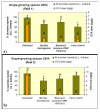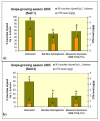Ochratoxin A management in vineyards by Lobesia botrana biocontrol
- PMID: 23282670
- PMCID: PMC3564067
- DOI: 10.3390/toxins5010049
Ochratoxin A management in vineyards by Lobesia botrana biocontrol
Abstract
Grape berries attacked by Lobesia botrana larvae are more easily infected by Aspergillus section Nigri (black aspergilli) ochratoxigenic species. Two-year field trials were carried out in Apulia (Italy) to evaluate a bioinsecticide control strategy against L. botrana and the indirect effect on reducing ochratoxin A (OTA) contamination in vineyards. A commercial Bacillus thuringiensis formulate and an experimental Beauveria bassiana (ITEM-1559) formulate were tested in two vineyards cultivated with the same grape variety, Negroamaro, but with two different training systems (espalier and little-arbor techniques). In both years and training systems the treatments by B. bassiana ITEM-1559 significantly controlled L. botrana larvae attacks with effectiveness similar to B. thuringensis (more than 20%). A significant reduction of OTA concentrations (up to 80% compared to untreated controls) was observed only in the first year in both training systems, when the metereological parameters prior to harvest were more favorable to the insect attack. Results of field trials showed that B. bassiana ITEM-1559 is a valid bioinsecticide against L. botrana and that grape moth biocontrol is a strategy to reduce OTA contamination in vineyard in seasons with heavy natural infestation.
Figures




Similar articles
-
Influence of Lobesia botrana field control on black aspergilli rot and ochratoxin A contamination in grapes.J Food Prot. 2009 Apr;72(4):894-7. doi: 10.4315/0362-028x-72.4.894. J Food Prot. 2009. PMID: 19435246
-
Effect of Lobesia botrana damages on black aspergilli rot and ochratoxin A content in grapes.Int J Food Microbiol. 2006 Sep 1;111 Suppl 1:S88-92. doi: 10.1016/j.ijfoodmicro.2006.03.012. Epub 2006 May 16. Int J Food Microbiol. 2006. PMID: 16707181
-
Managing ochratoxin A risk in the grape-wine food chain.Food Addit Contam Part A Chem Anal Control Expo Risk Assess. 2008 Feb;25(2):193-202. doi: 10.1080/02652030701744546. Food Addit Contam Part A Chem Anal Control Expo Risk Assess. 2008. PMID: 18286409
-
Pest Management and Ochratoxin A Contamination in Grapes: A Review.Toxins (Basel). 2020 May 7;12(5):303. doi: 10.3390/toxins12050303. Toxins (Basel). 2020. PMID: 32392817 Free PMC article. Review.
-
Fungi and mycotoxins in vineyards and grape products.Int J Food Microbiol. 2007 Oct 20;119(1-2):84-8. doi: 10.1016/j.ijfoodmicro.2007.07.031. Epub 2007 Aug 9. Int J Food Microbiol. 2007. PMID: 17765989 Review.
Cited by
-
Development of a rapid method for determination of Ochratoxin A in grape mash and wine.Mycotoxin Res. 2024 Nov;40(4):605-613. doi: 10.1007/s12550-024-00543-4. Epub 2024 Jul 21. Mycotoxin Res. 2024. PMID: 39033481
-
Potential biological control of the pupal stage of the European grapevine moth Lobesia botrana by the entomopathogenic fungus Beauveria pseudobassiana in the winter season in Chile.BMC Res Notes. 2019 Aug 28;12(1):548. doi: 10.1186/s13104-019-4584-6. BMC Res Notes. 2019. PMID: 31462292 Free PMC article.
-
Dual effects of entomopathogenic fungi on control of the pest Lobesia botrana and the pathogenic fungus Eutypella microtheca on grapevine.Biol Res. 2021 Dec 24;54(1):44. doi: 10.1186/s40659-021-00367-x. Biol Res. 2021. PMID: 34952648 Free PMC article.
-
"Ectomosphere": Insects and Microorganism Interactions.Microorganisms. 2023 Feb 9;11(2):440. doi: 10.3390/microorganisms11020440. Microorganisms. 2023. PMID: 36838405 Free PMC article. Review.
-
OTA-Grapes: A Mechanistic Model to Predict Ochratoxin A Risk in Grapes, a Step beyond the Systems Approach.Toxins (Basel). 2015 Aug 6;7(8):3012-29. doi: 10.3390/toxins7083012. Toxins (Basel). 2015. PMID: 26258791 Free PMC article.
References
-
- International Agency for Research on Cancer. Some Naturally Occurring Substances: Food Items and cConstituents, Heterocyclic Aromatic Amines and Mycotoxins. Vol. 56. IARC; Lyon, France: 1993. Monographs on Evaluation of Carcinogenic Risks to Humans; pp. 489–521.
-
- Somma S., Perrone G., Logrieco A.F. Diversity of black Aspergilli and mycotoxin risks in grape, wine and dried vine fruits. Phytopathol. Mediterr. 2012;51:131–147.
-
- Abarca M.L., Accensi F., Bragulat M.R., Cabañes F.J. Current importance of ochratoxin A-producing Aspergillus spp. J. Food Prot. 2001;64:903–906. - PubMed
MeSH terms
Substances
LinkOut - more resources
Full Text Sources
Other Literature Sources
Medical

